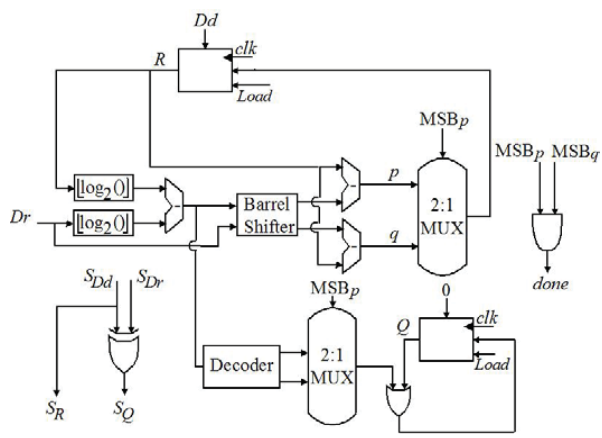A 32-bit Integer Division Algorithm Based on Priority Encoder
Also Available Domains Communications|Xilinx Vivado|Xilinx ISE
Project Code :TVMAFE470
Abstract
In this project, an algorithm for 32-bit integer
division is proposed. The algorithm calculates the integer division of positive
and negative dividends and divisors represented in sign and magnitude. It
calculates the magnitudes and signs of the quotient and remainder separately
based on the magnitudes and signs of the divided and divisor. In the algorithm,
the magnitude of the remainder is initially set to be the dividend and is
iteratively reduced until it becomes smaller than the magnitude of the divisor;
afterwards the algorithm converges. A priority encoder is used to improve the
convergence rate by skipping the zeros between the high bits while shifting the
divisor in each iteration to be aligned with the partial remainder. The
magnitude of the quotient is initially set to zero and updated based on the
amount of shift in each iteration. A hardware architecture is proposed to
implement the algorithm.
NOTE: Without the concern of our team, please don't submit to the college. This Abstract varies based on student requirements.
Block Diagram

Specifications
Software Requirements:
- Xilinx Vivado Tool
- HDL: Verilog
Hardware Requirements:
- Microsoft® Windows XP
- Intel® Pentium® 4 processor or Pentium 4 equivalent with SSE support
- 512 MB RAM
- 100 MB of available disk space
Learning Outcomes
- Basics of Digital Electronics
- VLSI design Flow
- Introduction to Verilog Coding
- Different modeling styles in Verilog
- Data Flow modeling
- Structural modeling
- Behavioral modeling
- Mixed level modeling
- Introduction to integer in binary representation
- Knowledge on division operation
- Different types of division algorithms
- Knowledge on subtractions
- Knowledge on barrel shifter & priority encoder
- Applications in real time
- Xilinx ISE 14.7/Xilinx Vivado for design and simulation
- Generation of Netlist
- Solution providing for real time problems
- Project Development Skills:
- Problem Analysis Skills
- Problem Solving Skills
- Logical Skills
- Designing Skills
- Testing Skills
- Debugging Skills
- Presentation Skills
- Thesis Writing Skills
Demo Video
Related Topics


 Paper Publishing
Paper Publishing

